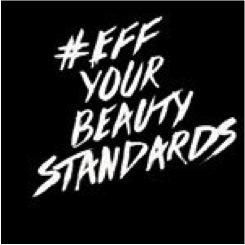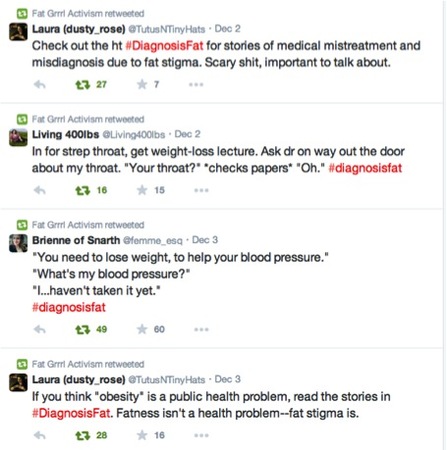
Doctoral candidate of Sociology
University of Massachusetts-Boston
In 2013, in Portland, Oregon, the fat positive revolution “got bigger.” A volunteer-run organization called Nolose (National Organization for Lesbians of SizE), centered on ending fat oppression and catalyzing a fat and queer positive culture, organized a conference to continue a conversation of fat acceptance at home and around the world. Part of the conference proceedings was the initiation of a project entitled “I need fat acceptance because…”, a platform on which individuals could express their reasons for needing and supporting a fat acceptance and fat positive ideology. The project has proliferated over the past few years, particularly in digital space on the popular social networking and blogging site Tumblr. Posts are both personal and overtly political, ranging from “I need fat acceptance because I am not going to hate my body anymore”, to “I need fat acceptance because it is decolonization”, to “I need fat acceptance because without it, there is no way to live in my body.” More posts in the project can be viewed here.
The politics of this project are indicative of the current cultural climate surrounding fatness in the United States; a push-pull of privilege and oppression, invisibility and representation, what society considers good or bad. The containment of fatness and fat bodies, particularly fat female and fat queer bodies, remains a paramount project at institutional, social, and cultural levels in the United States. Much of the persistent cultural anxiety surrounding fatness is predicated on the recognition of the power inherent in taking up space, literally and figuratively.
Because “fat” is deeply embedded in the Western collective conscience as unequivocally bad, size acceptance and fat positive movements have worked up against extreme derision and tacit body knowledges (Murray 2007) that have thus far precluded the movement from becoming more visible in the mainstream. However, something remarkable seems to be transpiring in contemporary digital spaces, with an unparalleled increase of visibility of fat bodies, and beyond this, an appreciation and lauding of fat female and fat queer bodies and what those bodies might represent in terms of meaningful social change. Through the literal presentation and performance of fatness in public domain online, body narratives of agency, empowerment, and love (of both the self and other fat bodies) are unsettling current feelings about fatness and potentially establishing a foundation for a fundamental cultural transformation, one that knows fat bodies as good bodies.
Nolose and the “I need fat acceptance” project are certainly not alone in their efforts. We are beginning to see multiple uses of online platforms and new media in spreading an ideology of body positivity and fat acceptance. There is very real resistance to attempts to constrain fat bodies—and the Internet is where the bulk of that resistance is taking place. In addition to making fat bodies visible via social media such as Tumblr, Instagram, and Facebook, there has also been an increase in online activist campaigns, specifically by way of hashtag activism; using Twitter hashtags for political/social/cultural activist efforts. Primarily, hashtag activism surrounding fat acceptance and body positivity is within the beauty and fashion, as well as the medical, frameworks.


This example is a significant reinforcement of fat being viewed as inherently unhealthy. #Losehatenotweight and Health at Every Size are centered on a holistic idea of health, promoting the reality that having a fat body and being a healthy individual are not mutually exclusive. These efforts have helped to expand discussion and public discourse on not only physical health, but mental and emotional health as well.
These re-imaginings of body politics through online activism, though welcome in many ways, remain complicated by constructs such as gender, race/ethnicity, class, ability, and sexuality. Body size is a dimension of diversity, and therefore must be approached intersectionally. We are not necessarily seeing equal representation in terms of how fatness is becoming visible in social media, and fat activism, much like feminism, is still largely a white, female enterprise. A recent example of a misstep in the body positive movement is the #aeriemen campaign—an advertising campaign for underwear that featured “real” men of various sizes and racial identities. Cis men are largely kept out of the conversation of body positivity; the assumption being that fat oppression does not extend to men in a heteronormative, patriarchal system. In fact, the campaign turned out to be a parody rather than a sincere approach to male body image issues. In order for fat acceptance to take hold and create tangible change, an intersectional approach is crucial, and this means working to make more fat bodies visible in digital spaces accessible by many, and move public discourses on fat acceptance from margins to mainstream.
Though we still have a long way to go in advancing fat acceptance, the reality is that online platforms can be and are being used to disrupt structures of corporeal containment through novel avenues of “taking up space”, making fatness visible on a global scale, and altering perceptions of fatness as a problem essentially in need of a solution. One could very much argue that the Internet, social media in particular, is now functioning as a space where body positivity and size acceptance are “trending.”
Erdman Farrell, Amy. 2011. Fat Shame: Stigma and the Fat Body in American Culture. New York: New York University Press.
Murray, Samantha. 2007. “Corporeal Knowledges and Deviant Bodies: Perceiving the Fat Body.” Social Semiotics 17(3): 361-373.
Rothblum, E. and Solovay, S. 2009. The Fat Studies Reader. New York: New York University Press.
 RSS Feed
RSS Feed
